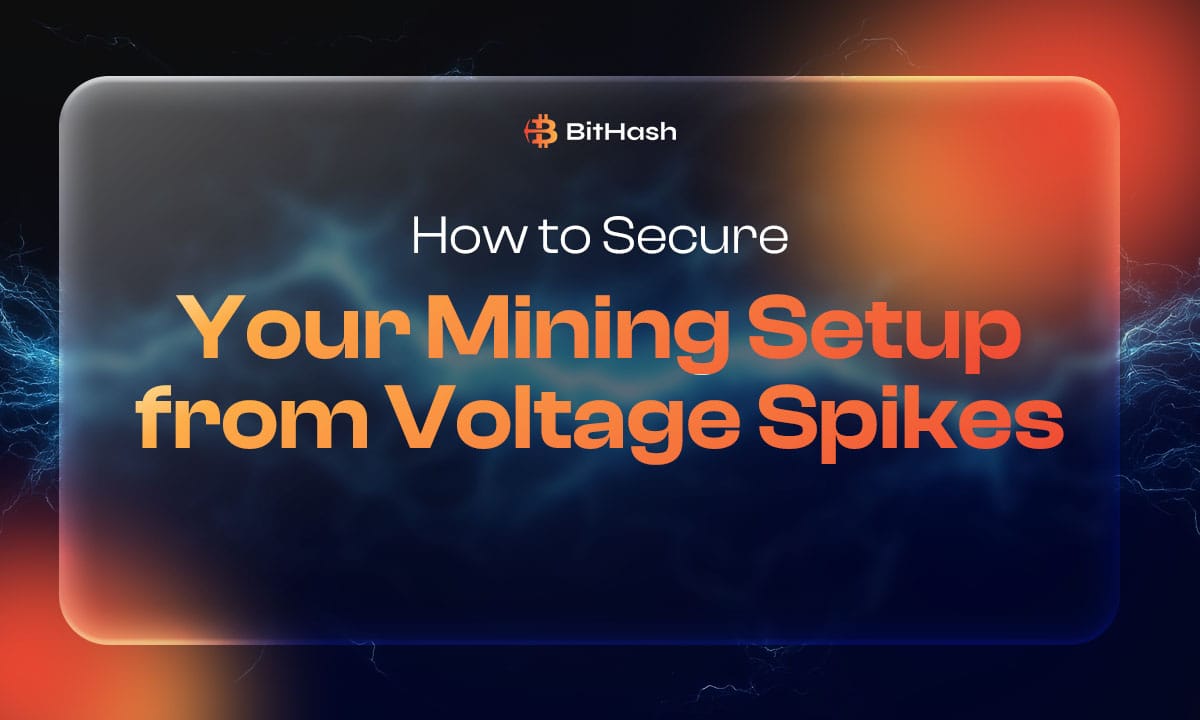Cryptocurrency mining demands a stable power supply to maintain efficient and uninterrupted mining operations. Whether you’re running high-performance ASIC miners or a custom GPU rig, protecting your setup from voltage spikes is crucial to avoid costly damage to your power supply unit, motherboard, and other components. In this guide, we’ll explore how to safeguard your crypto mining infrastructure from electrical fluctuations while optimizing your cooling system for hardware longevity.
As mining operations scale, the risk to your ASIC miners increases, especially when sharing resources in a mining pool. A reliable power supply unit and a well-designed cooling system are essential for ASIC miners. We’ll also dive into best practices for joining a mining pool, maintaining your cooling system, and ensuring your crypto mining setup is protected and profitable.
1. Understanding Voltage Spikes and Their Impact on Mining Rigs
In the world of cryptocurrency mining, maintaining a stable and secure electrical environment is just as important as optimizing your hash rate. One of the most overlooked threats to any mining operation is the occurrence of voltage spikes—also known as power surges. These sudden, short-lived increases in electrical voltage can wreak havoc on your crypto mining setup, damaging expensive equipment and disrupting your productivity.
What Are Voltage Spikes?
Voltage spikes are brief surges in electrical current that exceed the normal operating voltage of your system. These can be triggered by a variety of external and internal factors, including:
- Lightning strikes during storms
- Power grid fluctuations or instability
- Faulty wiring in your facility
- High-power appliances cycling on or off
- Utility company issues or maintenance errors
For mining operations, especially those running multiple ASIC miners, these spikes pose a serious risk. Without proper surge protection, your entire setup, including your power supply, power distribution system, and connected devices, can be compromised in seconds.
How Voltage Spikes Affect Mining Rigs
Voltage spikes can have devastating consequences for cryptocurrency mining rigs, particularly those operating in high-density environments or participating in a mining pool. Here’s how they impact your hardware and performance:
- Hardware Damage: Components, ASIC miners, motherboards, and the power supply are highly sensitive to electrical fluctuations. A single surge can damage circuits or permanently harm internal components, resulting in costly replacements and downtime.
- Data Corruption: Sudden shutdowns caused by voltage spikes can corrupt your crypto mining software, disrupt your connection to the mining pool, or even damage the operating system. This can result in lost mining time and reduced hash rate.
- Reduced Lifespan: Repeated exposure to voltage spikes degrades the integrity of your power supply, ASIC miners, and other critical components. Over time, this results in lower efficiency, increased maintenance costs, and a decline in overall hash rate.
- Fire Hazard: In extreme cases, voltage spikes can cause overheating, especially if your cooling system is not optimized. This poses a serious fire risk, endangering your equipment and the physical safety of your mining operation.
The Importance of Surge Protection
To protect your crypto mining investment, implementing robust surge protection is non-negotiable. This includes using surge-protected outlets, industrial-grade circuit breakers, and voltage regulators that stabilize the electricity flow to your mining rigs. For large-scale mining operations, integrating surge protection into your power distribution infrastructure is essential to prevent cascading failures.
Whether you’re mining solo or as part of a mining pool, safeguarding your power supply and maintaining a consistent hash rate requires proactive electrical management. With the right surge protection measures in place, your cryptocurrency mining setup can operate safely, efficiently, and profitably, even in the face of unpredictable power conditions.
2. Essential Protections Against Voltage Spikes
Voltage spikes are one of the most serious threats to any crypto mining rig, especially those running high-performance ASIC miners. These sudden surges in electrical current can damage sensitive mining equipment, disrupt operations, and even pose a fire hazard. To ensure the longevity and stability of your mining equipment, it’s critical to implement robust protective measures across your entire electrical infrastructure.
Whether you’re operating a solo rig or managing large-scale mining operations, protecting your ASIC miners, maintaining optimal hash rates, and ensuring energy efficiency starts with the right tools and setup. Here’s how to safeguard your investment:
A. Use a High-Quality Surge Protector
Not all surge protectors are designed to meet the demands of crypto mining rigs. High-performance ASIC miners require surge protectors with advanced specifications to handle the intense power load and protect against sudden spikes.
Key Features to Look For:
- Joule Rating: Select a unit rated at 2000 joules or more for enhanced surge absorption.
- Clamping Voltage: Look for models with clamping voltage below 400V to protect delicate components in your mining hardware.
- UL 1449 Certification: Ensures compliance with safety standards.
- EMI/RFI Filtering: Reduces electrical noise that can interfere with hashing power and system stability.
🔹 Recommended Brands: APC, Tripp Lite, Furman, trusted for protecting ASIC miners and other sensitive mining equipment.
B. Install an Uninterruptible Power Supply (UPS)
A UPS is essential for any serious mining operation, especially in areas prone to power outages. It not only provides backup power but also includes surge protection and voltage regulation to keep your ASIC miners running smoothly.
Key Features:
- Pure Sine Wave Output: Ideal for sensitive electronics, such as ASIC miners.
- Automatic Voltage Regulation (AVR): Stabilizes voltage during fluctuations.
- Sufficient Capacity: At least 1500VA for a 6-GPU or multi-ASIC miner setup.
🔹 Recommended Models:
- CyberPower CP1500PFCLCD
- APC BR1500MS
These models help maintain consistent hash rates and prevent data corruption in the event of unexpected power outages.
C. Use a Dedicated Mining Power Supply (PSU) with Protection Features
Your power supply unit is the backbone of your crypto mining rig. Investing in a high-quality PSU with built-in surge protection is vital for maintaining energy efficiency and protecting your ASIC miners.
Top PSU Models with Protection Features:
- Corsair HX/AX Series
- EVGA SuperNOVA G6/P6
- Seasonic PRIME TX
Avoid cheap PSUs; they often lack proper safeguards and can fail under high power load, risking damage to your mining equipment and reducing hashing power.
D. Install a Whole-House Surge Protector
For maximum protection, especially in large-scale mining operations, install a whole-house surge protector at your main electrical panel. This protects all circuits, including those powering your ASIC miners, cooling fans, and networking gear.
Benefits:
- Shields your entire electrical infrastructure from large surges (e.g., lightning strikes)
- Works in tandem with individual surge protectors
- Enhances safety and uptime for your mining hardware
🔹 Recommended Models: Siemens FS140, Eaton CHSPT2ULTRA
E. Ground Your Mining Setup Properly
Proper grounding is essential to prevent electrical faults and ensure safe operation of your ASIC miners and other mining equipment.
Best Practices:
- Use 3-prong plugs and never remove the ground pin.
- Test outlets with a ground tester to confirm safe connections.
- Maintain consistent grounding across all mining hardware and cooling fans to ensure optimal performance.
Good grounding also helps stabilize hash rates and protects against static discharge, which can damage sensitive components.
F. Monitor Voltage with a Smart Plug or Meter
Real-time monitoring of your power supply is crucial for detecting voltage fluctuations before they cause damage. Smart plugs and voltage meters help you track usage and detect anomalies.
Tools to Use:
- Smart Plugs: TP-Link Kasa, Wemo, monitor power draw and automate alerts.
- Voltage Meters: Kill-A-Watt, measure voltage, wattage, and power load.
- Remote Monitoring: IoT devices enable you to track performance and receive alerts even when you are off-site.
Monitoring tools also help optimize firmware updates, manage humidity levels, and fine-tune immersion cooling systems for better energy efficiency.
In conclusion, protecting your crypto mining rig from voltage spikes is a multi-layered process. From surge protectors and UPS systems to grounding and smart monitoring, each step plays a vital role in safeguarding your ASIC miners, maintaining stable hash rates, and ensuring the long-term success of your mining operations. With the right setup, you can maximize uptime, extend the lifespan of your hardware, and mine with confidence—even in volatile electrical environments.
3. Additional Best Practices for Mining Power Safety
Ensuring the safety and reliability of your crypto mining rig goes beyond surge protection. A comprehensive approach to power safety includes proper circuit management, high-quality components, remote control capabilities, and routine inspections. These practices not only protect your digital assets but also enhance thermal management, reduce downtime, and prevent costly damage to your mining equipment.
Whether you’re running a single ASIC miner or managing a large-scale farm, these professional techniques will help you maintain a secure and efficient mining environment.
A. Avoid Overloading Circuits
Overloaded circuits are a common cause of electrical fires and equipment failure in mining setups. Each ASIC miner and crypto mining rig should be connected to a dedicated 20A circuit to ensure safe handling of the high power load.
Best Practices:
- Never daisy-chain power strips; this increases the risk of overheating and fire.
- Label each circuit and monitor its usage to avoid accidental overload.
- Coordinate with an electrician to assess your electrical infrastructure and implement proper security measures.
Proper circuit allocation also supports better thermal management, especially when using cooling fans or a liquid cooling system.
B. Use High-Quality Cables & Connectors
Low-quality cables and connectors can lead to dust accumulation, overheating, and even electrical fires. For optimal safety and performance, invest in durable components designed for high-current loads.
Recommendations:
- Use 16AWG or thicker power cables for GPUs and ASIC miners.
- Avoid SATA-to-PCIe adapters, they are a known fire hazard and can trigger error messages or system crashes.
- Regularly inspect connectors for signs of wear, such as burnt smells, discoloration, or melted plastic.
Replacing worn-out cables promptly helps protect your digital assets and ensures consistent hash rates.
C. Implement Remote Power Cycling
Remote power cycling is a smart way to manage your mining hardware remotely, without requiring physical presence. This is especially useful when rigs freeze or display error messages due to voltage fluctuations or overheating.
Tools to Use:
- Wi-Fi Smart Plugs: Allow you to remotely reboot individual ASIC miners.
- Power Distribution Units (PDUs): Ideal for large-scale mining operations, offering centralized control and monitoring.
Remote control also supports your power backup strategy, allowing you to respond quickly during power outages or unexpected spikes.
D. Regular Maintenance & Inspections
Routine inspections are essential for identifying potential issues before they escalate. Dust, heat, and wear can degrade your mining equipment over time, affecting energy efficiency and triggering error messages.
Maintenance Checklist:
- Check for loose connections, frayed wires, and signs of corrosion.
- Clean out dust accumulation from PSUs, fans, and circuit boards to improve airflow and thermal management.
- Replace faulty surge protectors, cables, or PSUs immediately to prevent damage to your ASIC miners.
If you’re using a liquid cooling system, inspect tubing and coolant levels regularly to avoid leaks and maintain optimal hashing power.
What to Do If a Voltage Spike Occurs
Despite all precautions, voltage spikes can still happen. Knowing how to respond quickly can save your mining hardware and protect your digital assets.
Emergency Response Steps:
- Disconnect power immediately to prevent further damage.
- Inspect or discolored components.
- Test each component individually before restarting. Begin with the PSU, then move to the motherboard, GPUs, and ASIC miners.
- Replace damaged surge protectors’ components individually, as they are designed to absorb the spike and may no longer offer protection.
If you’re unsure about the extent of the damage, consult a technician trained in professional techniques to assess and repair your setup, including digital assets stored in hardware wallets.
By following these best practices, you can build a resilient and secure crypto mining rig that withstands electrical challenges and maintains peak performance. From circuit management and cable quality to remote control and emergency response, every detail contributes to a safer, more efficient mining environment.
Final Thoughts
Voltage spikes can destroy thousands of dollars’ worth of mining equipment in seconds. By using surge protectors, UPS systems, high-quality PSUs, and proper grounding, you can significantly reduce risks. Regular maintenance and monitoring ensure long-term stability and reliability.
DigitalPro Tip: If mining in an area with frequent storms or unstable power, consider a backup generator for extended outages.
By following these steps, your mining operation will be more reliable, efficient, and protected from electrical hazards.





